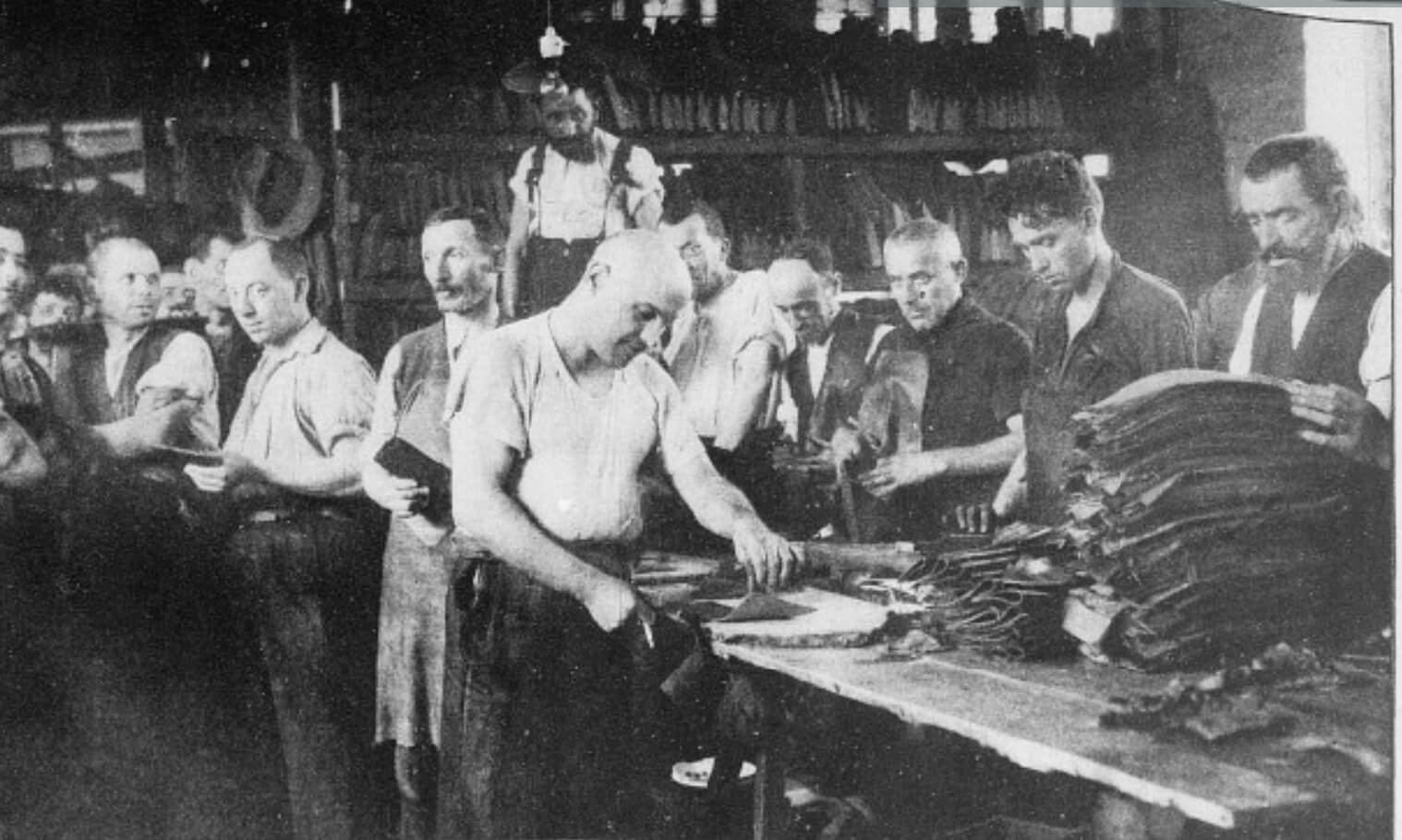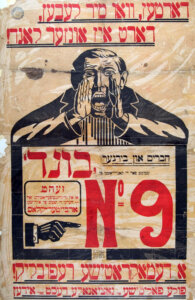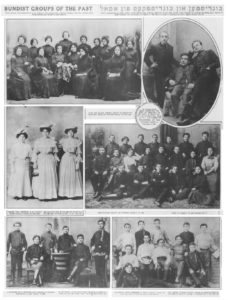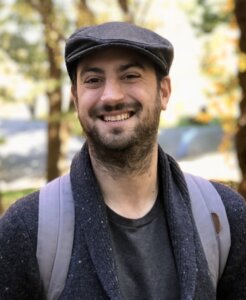In the story of two Jewish Bunds, a stark generational divide over Israel
A new Bund is trying to reclaim a storied history. Members of the old Bund say they’re ignoring important context.

Members of the Jewish Bund in Warsaw, Poland, circa 1926. Photo by Alter Kacyzne
When Amari Pavati, a sophomore at Binghamton University, organized a campus Shabbat dinner in early November, the double major in geography and classics made two pots of matzoh ball soup. Other students brought challah and grape juice for the 35 students who met outside in 40-degree weather.
It’s not that the students had no other Shabbat options. Binghamton University, part of the State University of New York system, has one of the largest Jewish student populations in the country. There are on-campus services for Reform, Conservative and Orthodox students. Hillel, the Chabad House, and the Orthodox Union campus group all host Sabbath meals. Pavati himself is on the executive board of Hillel’s queer Jewish club, Keshet.
But Pavati and the other students were organizing a “Cease-Fire Shabbat,” a cause that many mainstream Jewish organizations see as antithetical to being Jewish. Holding their dinner less than a month after the Oct. 7 Hamas attack on Israel, the organizers demanded the end of Israel’s siege of Gaza, which they called a “genocide.”
“We lit candles,” Pavati, who calls himself a non-Zionist, said, adding that they “sang the Mourner’s Kaddish, which was very explicitly mourning all of the victims of this war.” A vigil held by other Jewish groups on campus recognized only the Israeli victims.
Pavati and several other Jewish students are part of Students for Justice in Palestine, but they wanted to show that their pro-Palestine activism was because of, not despite, their Jewish values. The event launched a new student group: The New Yiddish Bund of Binghamton. It refers to the General Jewish Labor Bund of Poland, Lithuania, and Russia, a revolutionary socialist party founded in Vilna in 1897, the same year the political Zionism movement formed.
The Bund, the most influential political party among prewar Eastern European Jews, had mostly been forgotten, but it has recently gained attention for its opposition to Zionism. Where Zionists argued that Jews must create their own homeland to be safe from antisemitism, the Bund argued the future of Jews was linked to all workers, and they should stay and fight against repression wherever they happened to be living. They called this form of solidarity doikayt, Yiddish for here-ness, as opposed to Zionism’s there-ness. Doikayt, along with yiddishkeit (Yiddish language and secular Jewish culture) and socialism formed the three pillars of Bundism.

Pavati, who learned about the Bund the previous semester from a Yiddish professor, is one of many Gen Z Jewish progressives, who, feeling cast out by the Jewish establishment, have turned to the Bund for a non-Zionist Jewish ethos. Two weeks after the Cease-Fire Shabbat, a larger effort led by Democratic Socialists of America members launched to “revitalize the Bund.”
The group’s “manifesto” appeared online following Israel’s storming of the Al-Shifa Hospital in northern Gaza in late November. It expressed the anger and sense of urgency of activists at the time, casting “Israel as oppressor and the Palestinian people as the victims of Zionism’s bloody utopian vision.” It also challenged the idea of equating of anti-Zionism with antisemitism. “We are anti-Zionist Jews because we maintain the original, internal, steadfast, Jewish opposition to the precepts of Zionism,” the manifesto read, leveraging the Bund’s long legacy.
On campus, Pavati, with the New Yiddish Bund of Binghamton, is planning academic talks and cultural activities like a klezmer music event. They’ve also phone-banked for IfNotNow, a Jewish group that opposes U.S. support for what they call “Israel’s apartheid system,” and campaigned in defense of the Binghamton campus chapter of SJP, which the local congressman Marc Molinari deemed a “hate group.”
Online, Pavati has been part of discussions in chats with over 300 activists in the US, Canada, Latin America, and Europe about how to “remake” an organization that helped overthrow the Czar and brought dignity and rigor to Yiddish into a 21st-century political and cultural movement inclusive of all Jews, not just Ashkenazi.
Its core is under 30, which is unsurprising, given that a November poll conducted by the Jewish Electorate Institute found that nearly half of Jewish voters under 36 feel that President Biden is overly supportive of Israel, compared to only 18% of those over 35.
“It’s kind of unique to see 19- and 20-year-olds digging through archival files about the Bund,” Pavati said.
As much as younger Jewish activists like Pavati wish to resurrect the Bund, critics see romanticizing the Bund as a false nostalgia for a chapter of Jewish history defined by crippling discrimination. The Holocaust, they argue, proved the Bund wrong, showing the need for a Jewish state. Or, as President Biden put it: “Were there no Israel, there wouldn’t be a Jew in the world that is safe.”
But while the Bund was purged by Stalin, decimated by the Nazis, and mostly forgotten by postwar Jews who entered the middle class and shed their Yiddish socialist roots in favor of rallying around the state of Israel, it has never been extinct.
Meet the old Bund, not the same as the new Bund
“We are the Bund,” Dr. Doodie Ringelblum, a 60-year-old physician and president of the Melbourne Jewish Labour Bund, said on a video WhatsApp call from Australia. “We are the direct linear descendants of the immigrants from Eastern Europe who came to Australia to establish a Bund in Melbourne, and that Bund has continued uninterrupted.”
Melbourne is the lone survivor of the 30 Bundist chapters in 13 countries that existed after the Holocaust. The Melbourne Labour Bund has a Yiddish choir and runs year-round events, and a summer camp and youth group, SKIF. It hosts Australia’s largest Jewish event, the One Voice Festival, and organizes around labor, refugee and indigenous rights. Their meetings start with an aboriginal land recognition statement read in Yiddish.

“It bothers me when people say the Bund is being ‘revived.’ It has never gone away,” Ringleblum, a third-generation Bundist, said. In addition to this new group, there is a Berlin-based “Jewish Bund” founded in 2021. Ringelblum said he has been contacted at least five other times in the past four years by people wishing to restart the Bund. He’s pleased by the renewed interest but worries that some calling themselves Bundists or even getting doikayt tattoos might be doing so for the wrong reasons.
The 127-year-old movement is an inspiration to Jewish ceasefire activists and a point of reference for Jewish anti-Zionism in the press. However, the Melbourne Bund, the original Bund, has taken a more moderate stance on the conflict.
The Melbourne group has not endorsed or participated in any pro-Palestine or pro-Israel rallies. It sees itself as staking a nuanced position between the two opposing camps. They maintain “that all people in Israel, Gaza, and the West Bank have a right to self-determination and freedom from oppression and violence.”
Since Oct. 7, the Bund has made two online statements drafted by their committee with members ranging from their teens to their 70s. The first, on Oct. 10, condemned the Hamas attack and affirmed Israel’s right to defend itself while calling on it to “make maximal efforts to avoid civilian casualties.” The second, on Dec. 30, called for an end to Israel’s siege and blockade of Gaza. Israel’s military victories, it declared, were “achieved at a massive cost to innocent Palestinians.”
“There is suffering, not necessarily symmetric equal suffering, but there is suffering being experienced by lots of people on all sides,” Ringelblum said, explaining that their statements attempted to “acknowledge that without justifying immoral, improper behavior.”
The manifesto of the new Bund, however, draws the comparison between “the devastation of Gaza” and the fate of Jews “in the Ghetto walls,” but does not mention the Hamas attack. Nor does its call to “remake the Jewish Labor Bund” discuss labor issues. A Zoom call with 10 members of the new Bund made it clear that they are attracted to a Bundist anti-Zionist legacy that the actual Bund no longer maintains.
The Melbourne Bund’s position isn’t an anomaly. The New York-based Jewish Labor Committee and Paris’ Centre Medem Arbeter Ring, both founded in part by the Bund, have issued only statements in support of Israel. In November, Ann Toback, chief executive of the Worker’s Circle, a New York group with Bundist roots, told The New York Times her organization “won’t choose sides.” Citing doikayt, she said her group focused on domestic issues. The one exception is the Boston Worker’s Circle branch, which participated in a ceasefire rally, which led to it being forced out from a local Jewish coalition.
At play is a generational divide. Older progressive Jews have not come out as strongly against Israel as younger Jews. For instance, Bernie Sanders has disappointed his Gen Z supporters by not calling for a ceasefire. Even within the Melbourne Bund, Ringelblum told me, younger members wished the group had criticized the Netanyahu government more forcefully. But this difference also reflects a longtime debate on how Bundists, or progressive diaspora Jews in general, should relate to Israel, a country whose politics are increasingly at odds with their values but where almost half of the world’s Jews live.
An alternative to Zionism
Ethan Shafron remembers questioning Zionism as a teenager in the Conservative Jewish movement in Shaker Heights, Ohio. “I personally felt like there were literally no spaces for me to make sense of what it means to be a Jew and uncomfortable with the state of Israel,” Shafron, now a 26-year-old doctoral student at the University of Montana, said over Zoom.
The aftermath of Israel’s response to the Oct. 7 Hamas attacks has deepened these divisions. Many Gen Z and millennial Jews are horrified at the devastating siege of Gaza, while older Jews and Jewish community leaders are more likely to view Israel as fighting for survival. To them, opposition to Israel’s efforts is not just wrong or un-Jewish but antisemitic. In turn, anti-Zionist campus groups have been banned, activists have been doxxed, and families divided.

Dovy Ehrenreich, a 25-year-old musician and educator from Brooklyn, grew up deeply connected to Israel, and lived there during a gap year program. “My mom told me that after Oct. 7, she was frankly worried I was going to join the IDF,” he said. Only recently did he reveal that he had become disillusioned with Zionism. He now attends ceasefire protests, while, he says, his father posts photos online of Israeli missiles with the family name scrawled on them. “I don’t speak really with my parents now,” he said.
Groups like Jewish Voice for Peace, IfNotNow, and Palestinian solidarity organizations give opportunities for anti-Zionist Jewish activists to voice what they’re against. But feeling ostracized by Jewish institutions and their communities, anti-Zionist Jews yearn for something more than a protest movement.
“They’re going to set up their own learning centers; they’re going to set up their own summer camps; they’re going to set up their own synagogues,” Shaul Magid, a professor of Judaic studies at Dartmouth University and author of the book The Necessity of Exile, predicted in December on the Jacobin magazine podcast The Dig. In The New York Review of Books, the writer David Klion recently promoted creating an alternative anti-Zionist Jewish communal life.
The new Bund promises more than a Jewish community for anti-Zionists and other marginalized groups like queer, trans, non-white, and patrilineal Jews. It offers a Jewish heritage and the chance to reclaim a lost lineage, either spiritual or literal.
Ehrenreich’s grandfather, a Holocaust survivor, was a Bundist in Poland, and Pavati recently learned of his great-great grandmother’s Bundist connections. D.J. Waletzky, a 43-year-old computer engineer from Brooklyn whose great-grandfather was the first treasurer of the New York Bund and who is an unofficial leader of the New Bund, said that most members do not have family connections, but found the group because they were “in a search for an alternative to Zionism.”
Ringelblum, however, worries that the legacy of the Bund will be reduced to one issue. His grandparents, who were killed in Treblinka, were part of the movement in Poland, and his father, born in Warsaw, started the Melbourne Bund’s summer camp after the war. He and his wife raised their three children speaking Yiddish in the movement. “If they see the Bund as merely an alternative to Zionism,” he said, “they’re missing the point.”
Still, the Australian Bund is interested in expanding and has been in touch with Waletzky, whose grandmother was Tsirl Waletzky, a renowned artist and Yiddish educator in New York. His father, Josh Waletzky, who is also involved in organizing the new Bund, is a celebrated Yiddish singer and award-winning filmmaker, having directed the acclaimed 1981 documentary about Jewish life in Poland, Image Before My Eyes.
“He’s certainly somebody who knows what the Bund was and probably what the Bund is,” Ringelblum said of Waletzky.
Rebuilding a culture that has been washed away
The renewed interest in the Bund came with the election of Donald Trump and the continued reign of Benjamin Netanyahu. With the rise of figures like Bernie Sanders and Alexandria Ocasio-Cortez, the Bund was a natural fit for millennial Jews opposed to Israel’s occupation of Palestinian territories. Around that time, groups like Jews For Racial and Economic Justice, long inspired by the Bund, started posting on social media about doikayt, which was cited as a guiding principle in the 2018 relaunch of the progressive magazine Jewish Currents.
Articles, podcast episodes, books, and a graphic novel about the Bund followed. In “My great-grandfather the Bundist,” a 2018 New York Review of Books article, artist and writer Crabapple, who is also an Occupy Wall Street alum and DSA activist, weaves her personal story of discovery with a prewar history of the Bund. Having reported on the West Bank, she concludes that doikayt is the needed antidote to Israel’s “ethnonationalism,” which she calls a “poison” that “has continued to reap a harvest of repression and death.”

Since October, Crabapple, who is currently writing a book on the Bund, has been sharing Bundist quotes on social media; although they were written decades ago in Yiddish, they sound like modern critiques of Israel, like this one from the leader Henryk Erlich in 1938:
“If a Jewish state is to be founded in Palestine, its spiritual climate will be: an eternal fear of the external enemy (Arabs), unending fighting for every piece of land, for every scrap of work against the eternal enemy, and a tireless struggle for the eradication of the language and culture of the non-Hebraized Jews of Palestine.”
Ringelblum also proudly cites these predictions but warns they must be understood in their context: prewar Europe when a Jewish state was still an unlikely utopian idea.
Bundists distinguished between supporting the Jewish community living in Israel and opposing Zionism. Anti-Zionism came to mean believing that a Jewish state was not the solution to the problems of world Jewry and that Israel was not the center of Jewish life. Bundists advocated for Yiddish speakers in Israel and supported the right of return of Palestinian refugees and equal rights for Arab Israelis. Over time, their support for a one-state binational solution became support for a two-state solution.
Speaking on a 2020 episode of the podcast Treyf, David Slucki, a Monash University Professor of history and author of the book The International Bund after 1945, said that Bundist communities eventually became “extremely supportive of Israel and incorporated it as part of their Jewishness and Jewish identity.”
“Real-life Bundists in the 1980s and ’90s were not anti-Zionist in the ways that people in 2020 imagine,” he added.
“We support Jews and Jewish communities wherever they may be,” Ringelblum said. Bundists, he explained, are internationalists, meaning they dislike all forms of nationalism. “I don’t think that Zionism, Jewish nationalism, is any different to Palestinian nationalism, Australian nationalism, or American nationalism.”
While Bundists were anti-Zionists who came to accept Israel, many new Bundists grew up with close ties to Israel but have become anti-Zionists. Several talked to me about “unlearning” the Zionism they were taught in Hebrew school and Jewish summer camps.
After growing up with Jewish institutions that placed support of Israel at the center of Jewish identity, these mostly younger Jews are reaching back to decades-old Bundists for a Jewishness focusing not on statehood, but on a solidarity untainted by Zionism. “My bobe never made hummus,” Waletzky said. “We’re trying to rebuild the lives in the diaspora and the culture that has been washed away,” he said.
A growing split within diaspora communities
Helen Paloge, who teaches Yiddish in Israel and attended the New York Bundist summer camp Hemshekh in the 1960s, says Bundism and celebrating the diaspora does not mean rejecting Israel. She’s concerned about a growing gap between diaspora progressives and Israel and has been reaching out to former Bundist campers, hoping they engage like-minded Israelis invested in the future of both Israelis and Palestinians. “The spirit of doikayt can be reassessed, and the whole conception of here vs. there rethought to suit the times and include Israel, a place where over 7 million Jews live in our Here,” she wrote in an email.

“To talk about a diaspora identity without acknowledging that about half the world’s Jews live in Israel is ignoring the reality of the Jewish world,” Ringelblum told me. Likewise, he’s concerned about a growing split within diaspora Jewish communities as Jewish institutions shun anti-Zionists and young progressives like the new Bundist declare that “today’s Jewish institutions have nothing to offer a Jew of conscience.”
Despite these differences, Ringelblum continues to speak with Waletzky. “One of the beauties of the Bund as an organization is that it’s always accepted and tolerated and even encouraged minority views,” said Ringelblum — that democratic principle that has allowed it to survive and adapt from Tsarist Russia and Nazi-occupied Poland to Cold War America, Peronist Argentina, and Zionist Israel. “We’re happy to have a diversity of opinion,” he said.
It’s perhaps this diversity of opinion over time that makes it so appealing. Each person can identify with a different form of Bundism.

















